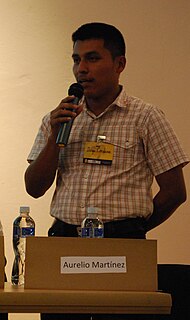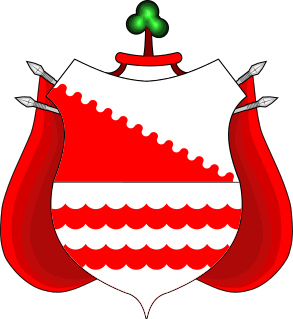Nicaragua is a nation in Central America. It is located about midway between Mexico and Colombia, bordered by Honduras to the north and Costa Rica to the south. Nicaragua ranges from the Caribbean Sea on the nation's east coast, and the Pacific Ocean bordering the west. Nicaragua also possesses a series of islands and cays located in the Caribbean Sea.

The Mosquito Coast, also known as the Mosquitia, Mosquito Shore and the Mosquito Kingdom, historically included the area along the eastern coast of present-day Nicaragua and Honduras. It formed part of the Western Caribbean Zone. It was named after the local Miskitu Nation and was long dominated by British interests. The Mosquito Coast was militarily incorporated into Nicaragua in November 1894; however, in 1960, the northern part was granted to Honduras by the International Court of Justice.

The Miskitus are a native people in Central America. Their territory extends from Cape Camarón, Honduras, to Río Grande de Matagalpa, Nicaragua, along the Mosquito Coast, in the Western Caribbean Zone. Their population is estimated at 700,000 people as of 2021 according to the official Miskitu Database.

Bluefields is the capital of the South Caribbean Autonomous Region in Nicaragua. It was also the capital of the former Kingdom of Moskitia, and lately Zelaya Department, which was divided into North and South Caribbean Coast Autonomous Regions. It is located on Bluefields Bay at the mouth of the Bluefields River in the municipality of the same name.

The Misumalpan languages are a small family of languages spoken by indigenous peoples on the east coast of Nicaragua and nearby areas. The name "Misumalpan" was devised by John Alden Mason and is composed of syllables from the names of the family's three members Miskito, Sumo languages and Matagalpan. It was first recognized by Walter Lehmann in 1920. While all the languages of the Matagalpan branch are now extinct, the Miskito and Sumu languages are alive and well: Miskito has almost 200,000 speakers and serves as a second language for speakers of other indigenous languages in the Mosquito Coast. According to Hale, most speakers of Sumu also speak Miskito.

River Wangki in Miskitu or Río Coco, in Spanish, formerly known as the Río Segovia, Cape River, or Yara River, is a river located on the border of northern Nicaragua and southern Honduras. It is the longest river that runs entirely within the Central American isthmus with a total length of 841 km (523 mi).

The Mayangna are a people who live on the eastern coasts of Nicaragua and Honduras, an area commonly known as the Mosquito Coast. Their preferred autonym is Mayangna, as the name "Sumo" is a derogatory name historically used by the Miskito people. Their culture is closer to that of the indigenous peoples of Costa Rica, Panama, and Colombia than to the Mesoamerican cultures to the north. The Mayangna inhabited much of the Mosquito Coast in the 16th century. Since then, they have become more marginalized following the emergence of the Miskito as a regional power.
The Bosawás Biosphere Reserve in the northern part of state Jinotega, Nicaragua is a hilly tropical forest designated in 1997 as a UNESCO biosphere reserve. At approximately 20,000 km² in size, the reserve comprises about 15% of the nation's total land area. Combined with the biosphere of the banana river in Honduras, which is continguous with the jungle of the Bosawás reserve, it is the second largest rainforest in the Western Hemisphere, after the Amazon in Brazil. Bosawás is largely unexplored, and is extremely rich in biodiversity.

The Rama are an indigenous people living on the eastern coast of Nicaragua. Since the start of European colonization, the Rama population has declined as a result of disease, conflict, and loss of territory. In recent years, however, the Rama population has increased to around 2,000 individuals. A majority of the population lives on the island of Rama Cay, which is located in the Bluefields Lagoon. Additional small Rama communities are dispersed on the mainland from Bluefields to Greytown. The Rama are one of three main indigenous groups on Nicaragua’s Caribbean coast.

Joel Bryan Mayes was Principal Chief of the Cherokee Nation.

There are 12 monarchies in the Americas. Each is a constitutional monarchy, wherein the sovereign inherits his or her office, usually keeping it until death or abdication, and is bound by laws and customs in the exercise of their powers. Nine of these monarchies are independent states; they equally share Queen Elizabeth II, who resides primarily in the United Kingdom, as their respective sovereign, making them part of a global personal union known as the Commonwealth realms. The others are dependencies of three European monarchies. As such, none of the monarchies in the Americas have a permanently residing monarch.
The western Caribbean zone is a region consisting of the Caribbean coasts of Central America and Colombia, from the Yucatán Peninsula in southern Mexico to the Caribbean region in northern Colombia, and the islands west of Jamaica are also included. The zone emerged in the late sixteenth century as the Spanish failed to completely conquer many sections of the coast, and northern European powers supported opposition to Spain, sometimes through alliances with local powers.
The Miskito Sambu, also known simply as the Miskito, are an ethnic group of mixed cultural ancestry occupying a portion of the Caribbean coast of Central America known as the Mosquito Coast region. Although older records, beginning with Spanish documents of the early 18th century, refer to the group as "Mosquitos Zambos", modern ethnographic terminology uses the term Miskito.
Edward I was king of the Mosquito Nation, from about 1729 until 1755. He was the eldest son of Jeremy II, and was young when he took office.

George I was king of the Miskito Kingdom from 1755 to 1776. He was brother of King Edward and son of Jeremy II and was chosen king because Edward's eldest son was still too young to rule.

Afro-Hondurans or Black Hondurans are Hondurans of Sub-Saharan African descent. The CIA world factbook regards their population to be around 2% of the country's population, but the percentage of Afro-Hondurans is actually 10% counting the Garifunas.Estimates vary with concervative estimates ranging as low as 1% and higher estimates ranging to 30%. They descended from: enslaved Africans by the Spanish, as well as those who were enslaved from the West Indies and identify as Creole peoples, and the Garifuna who descend from exiled zambo Maroons from Saint Vincent. The Creole people were originally from Jamaica and other Caribbean islands, while the Garifuna people were originally from Saint Vincent and the Grenadines. Garifunas arrived in the late seventeen hundreds and the Creole peoples arrived during the eighteen hundreds. About 600,000 Hondurans are from Garífuna descent that are a mix of African and indigenous as of Afro Latin Americans. Honduras has one of the largest African community in Latin America. The total of Garifuna, Creole, and African population estimation is about 3,000,000 with about 30% estimation of Honduras, Which makes Honduras have the highest population of blacks in Central America. In total it is about 884,000 Hondurans of African descent which is an estimate of Garifunas and Africans all together.
Since the mid-twentieth century, indigenous organizations in Nicaragua have historically formed in response to economic, political, and cultural injustices and to create infrastructure for self-governance. They most often represent their motives and goals as pan-indigenous and do not employ Marxist or Leninist ideas or language of class struggles. Although many organizations stress Miskitu ethnicity, language, and history, most major Nicaraguan indigenous organizations have advocated on behalf of indigenous peoples in general.

The Spanish conquest of Honduras was a 16th-century conflict during the Spanish colonization of the Americas in which the territory that now comprises the Republic of Honduras, one of the seven states of Central America, was incorporated into the Spanish Empire. In 1502, the territory was claimed for the king of Spain by Christopher Columbus on his fourth and final trip to the New World. The territory that now comprises Honduras was inhabited by a mix of indigenous peoples straddling a transitional cultural zone between Mesoamerica to the northwest, and the Intermediate Area to the southeast. Indigenous groups included Maya, Lenca, Pech, Miskitu, Mayangna (Sumu), Jicaque, Pipil and Chorotega. Two indigenous leaders are particularly notable for their resistance against the Spanish; the Maya leader Sicumba, and the Lenca ruler referred to as Lempira.
The Spanish conquest of Nicaragua was the campaign undertaken by the Spanish conquistadores against the natives of the territory now incorporated into the modern Central American republic of Nicaragua during the colonisation of the Americas. Before European contact in the early 16th century, Nicaragua was inhabited by a number of indigenous peoples. In the west, these included Mesoamerican groups such as the Chorotega, the Nicarao, and the Subtiaba. Other groups included the Matagalpa and the Tacacho.
Charles R. Hale is a scholar of Latin America, Africa, and the African diaspora. He was appointed Dean of Social Sciences at the University of California, Santa Barbara in 2018 and professor of global studies. He is a past president of the Latin American Studies Association (2006-2007). He earned an A.B. in Social Studies at Harvard College and his doctorate at Stanford University. His publications include two single-author books, which have been translated to Spanish, “…más que un indio ”: Racial Ambivalence and Neoliberal Multiculturalism in Guatemala; and Resistance and Contradiction: Miskitu Indians and the Nicaraguan State, 1894-1987.












